Spraying grapes in spring from diseases and pests
In order for the grapes to please with their appearance (to be healthy) and, most importantly, to bear fruit abundantly, it is important not only to form it correctly (cut off annually in autumn and spring), tie it up and feed, but also timely carry out preventive and therapeutic treatments of the vine against fungal diseases and insect pests ...
Below you will find all the relevant and useful information about spraying grapes in the spring against diseases and pests!
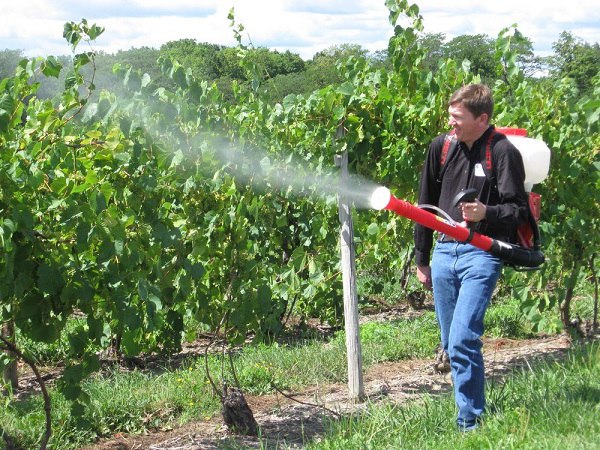
Content
Why do you need to process and spray grapes in spring
The main purpose of the spring processing of grapes is to prevent infection of the vine with diseases caused by various spores of fungi, as well as to destroy and repel insect pests. Timely and competent spraying of grapes in spring and summer will help protect the vine, which means that, other things being equal, you will get a rich harvest.
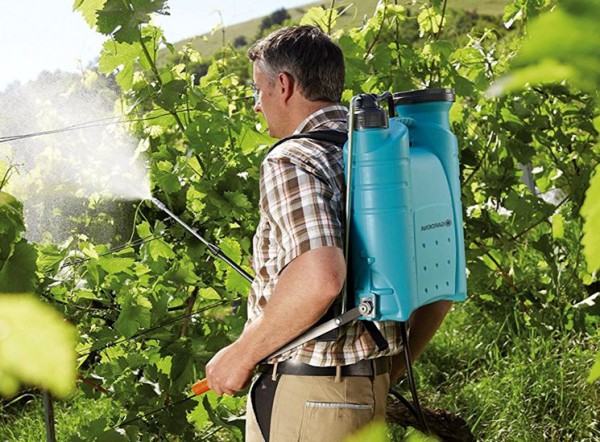
As you know, any problem is easier to prevent than to deal with (treat) it later. Therefore, so that the plant does not suffer from misfortunes, it is better to strictly follow the established processing schedule in spring and summer.
Naturally, in order to understand which drug (fungicide, insecticide or acaricide) to spray grapes, you need to know its enemies "by sight".
Diseases
The vine is susceptible to the following fungal diseases:
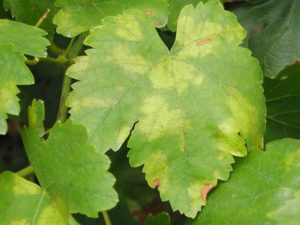
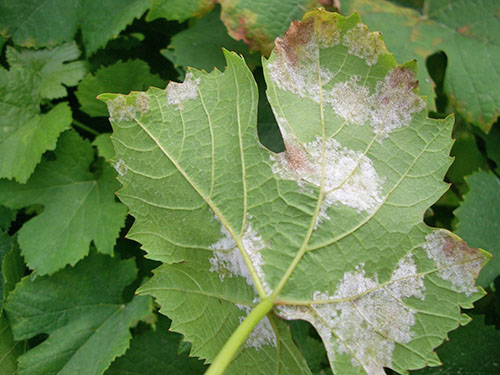
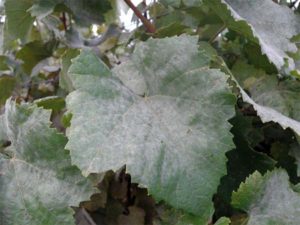
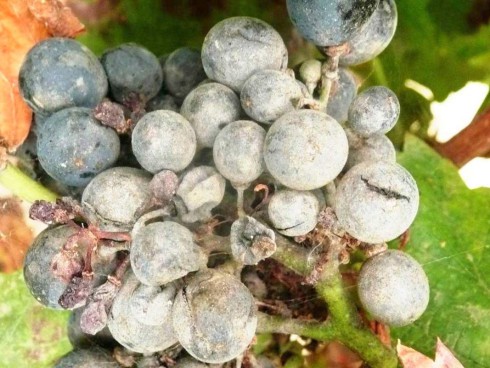
Mildew (downy mildew) and oidium (powdery mildew) are the most harmful and frequent diseases of grapes.
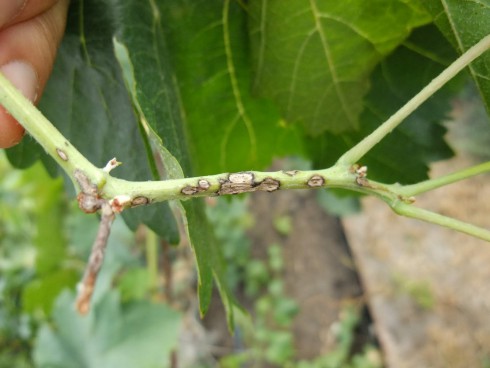
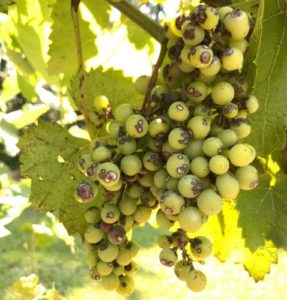
- phomopsis (black spot, excoriasis, dry sleeves);
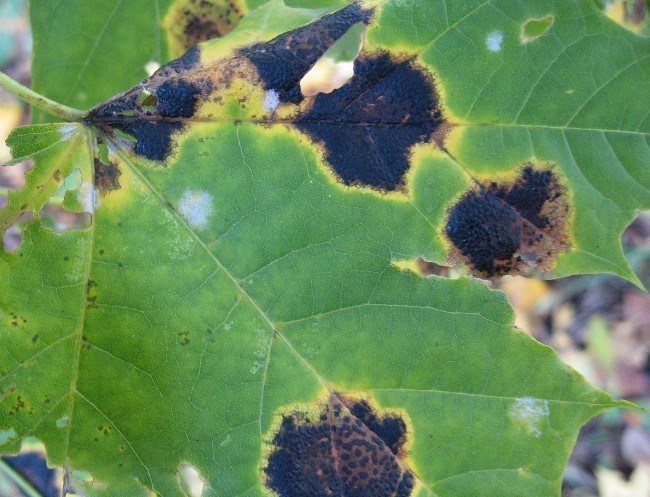
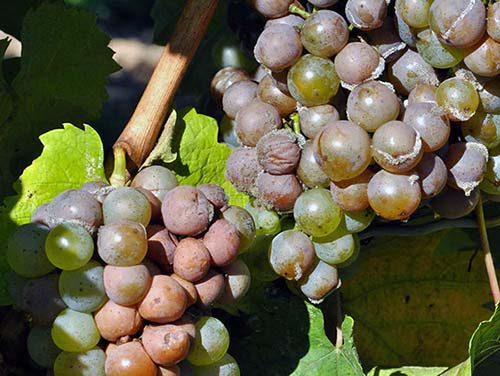
- black rot;
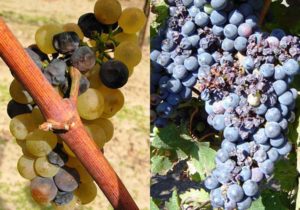
- white rot;
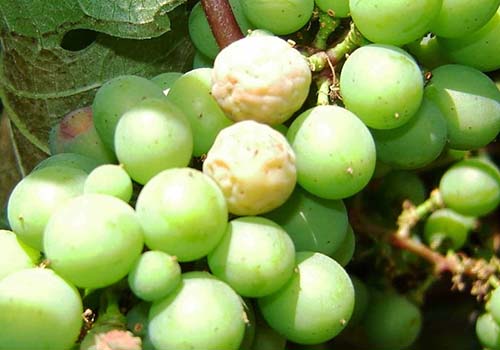
- rubella.
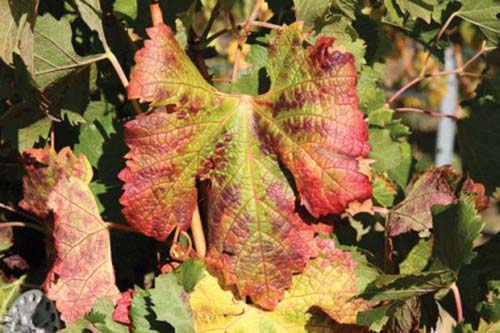
Video: dangerous grape diseases and how to deal with them
Pests
The most dangerous and common pests of grapes are:
- pincers (grape felt mite (itch), common spiderweb, etc.);
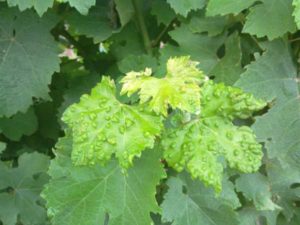
- phylloxera (root and leaf grape aphids);
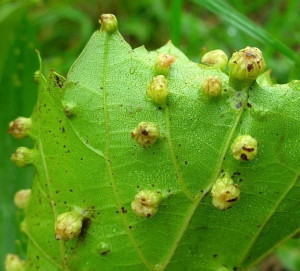
- leaf rollers (grape, biennial, bunchy, etc.);
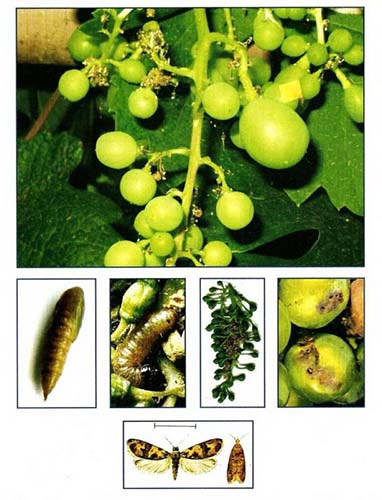
- thrips;
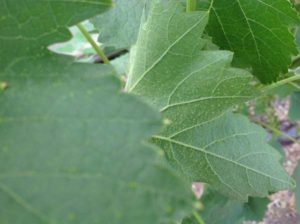
- leafhoppers.
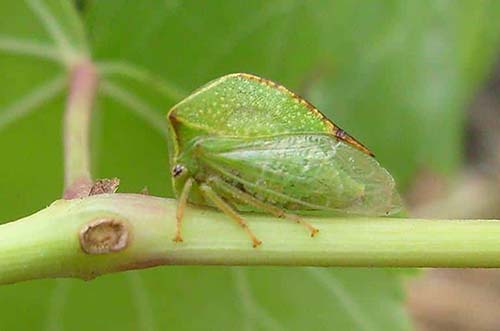
Also don't forget and about the following garden and vegetable garden pests:
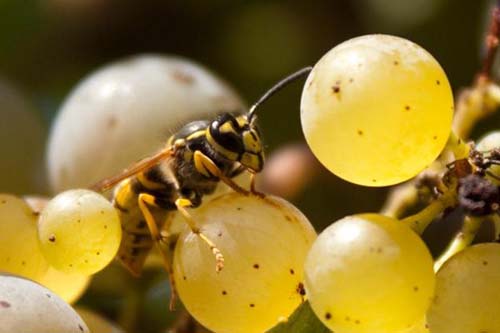
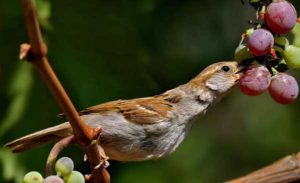
- slugs and snails.
By the way! Although slugs and snails are not really dangerous enemies for grapes, the ways to protect and combat these "slimy" pests are detailed. here.
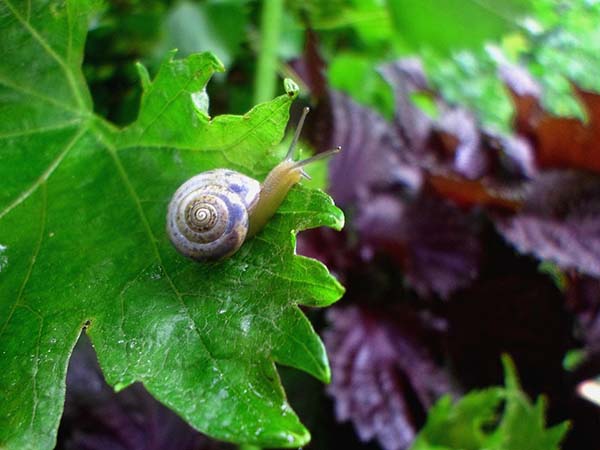
Attack of insect pests can be noticed by the presence of the following characteristic features:
- Deformation of leaves and shoots (the leaf roll rolls the leaves into tubes, gluing them together with its cobweb).
- The appearance of damaged areas on leaves and stems (plant tissues serve as food for many species of caterpillars, ticks).
- Direct damage to berries. They love to feast on sweet berries wasps and sparrowsas well as some other insects.
Experience shows that with a minor attack of insect pests, they can be destroyed (removed) mechanically. Namely, to carry out their manual collection, remove (tear off) damaged leaves (for example, the same tick).
Video: grape pests
However, in order to prevent severe infection, it is necessary to begin prophylactic spraying of grapes with special preparations from early spring, and also be sure to return to treatments in case of detection of the first signs of the development of diseases and the presence of pests.
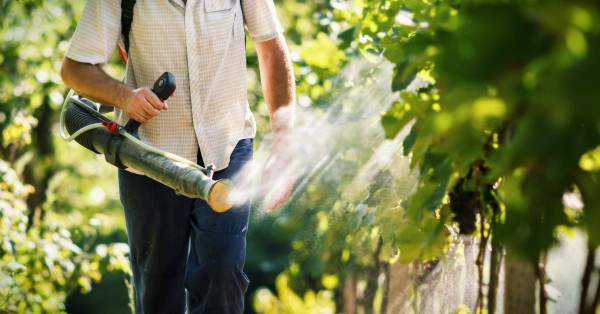
Video: diseases and pests of grapes - the fight against them
When to spray grapes from pests and diseases in the spring: the optimal time for processing the vines
Note! Obviously, different pests and diseases appear at different times, respectively, for each phase of grape development there should be its own specificity of processing. Naturally, it is very difficult to name specific dates, it is much easier to navigate by the phases of development (vegetation) of the berry bush in spring.
Thus, the scheme for processing grapes in spring and summer involves the following preventive and therapeutic spraying:
In this case, the most important are 1, 2, 3, and 5 (they can be called preventive):
- After removing the shelter and the garter to the trellises (along the bare branches) = during the period of swelling of the kidneys (early spring eradication treatment).
- Dissolving buds and formation of leaves (shoots reach a length of 10-15 cm, the appearance of the first 3-4 leaves).
- Inflorescence formation (budding).
- During flowering (optional).
- Formation of berries (after flowering, when the berries are the size of a "pea").
- During ripening, but before harvesting (closing of berries in bunches and the beginning of their coloring).
- After harvest (in autumn).
Note! More details about the autumn eradicating treatment of grapes from diseases and pests readin this article.
Next, we will analyze each stage in more detail.
A selection of interesting videos
In the following videos, the amateur gardener shares with its own spray pattern grapevine throughout the season, and also disassembles processing schemes from the agro store "Fazenda", companies Syngenta and Bayer (well-known pesticide manufacturers)
Video: scheme for the treatment of vines from diseases and pests from Vladimir Mayer
Video: a scheme for processing grape bushes from diseases and pests from the Fazenda agro store
Video: scheme for the treatment of grapes from diseases from the Syngenta company
Video: a scheme for the treatment of grapes from diseases from Bayer
On bare vine and during bud swelling
The first preventive spraying of grapes is carried out on a still dormant vine and onlyat a positive temperature above +4 .. + 5 degrees.
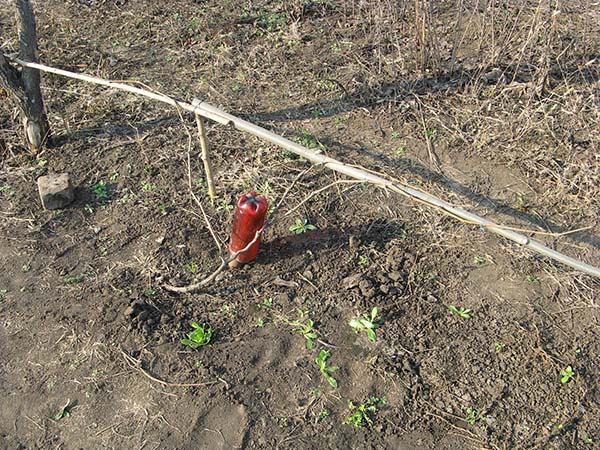
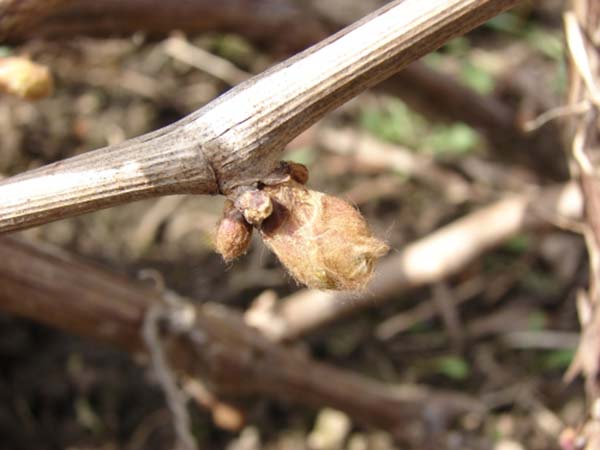
At this time, it makes sense to use only contact means, since the spores of the fungus have not yet penetrated deep into the plant, but are in hibernation or are just beginning to wake up.
Moreover, it is necessary to process not only the vine, but also the soil under it.
For the first time during this period, grape bushes, as a rule, are treated with the simplest copper-containing preparations (based on copper sulfate) - a 3% solution copper sulfate or bordeaux liquid.
Some gardeners mistakenly advised to carry out the first processing of grapes iron vitriol, however, it was necessary to spray the vine with this preparation even in autumn (during autumn eradication spraying).
Video: the first spring treatment of grapes with copper sulfate
Dissolving buds and formation of leaves
At this stage of the growing season of grapes, you can already start using systemic drugs.
However! According to some winegrowers, the first treatment can still be carried out with a contact preparation (based on copper, for example, with copper chloride = "Abiga-Peak" preparation), but the second and subsequent treatments must be systemic.
Moreover, at this stage, it is advisable to have time to carry out at least 2 treatments, and even better 3 (every 7-14 days).
- 1 treatment in the "green cone" stage, when the buds are just beginning to bloom (with contact copper-containing, for example, copper chloride = "Abiga-Peak" preparation).
And also it is desirable to process something from grape mites.
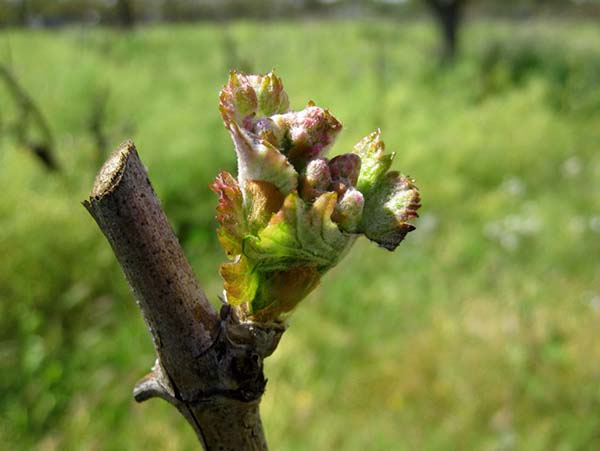
- 2 processing, when young shoots reach a length of 10-15 cm and 3-4 leaves appear on them.
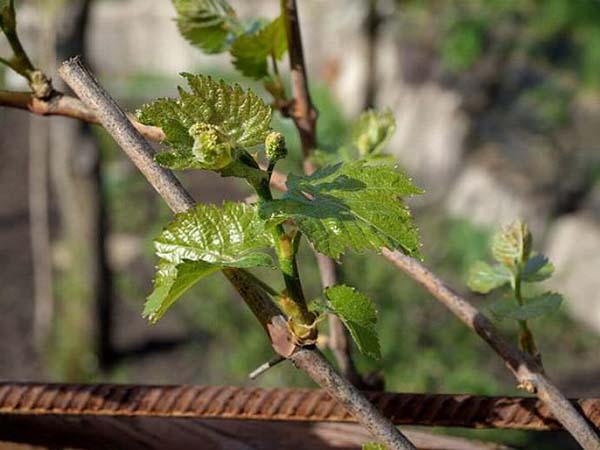
Diseases:
- At this stage, they begin to process from mildew, anthracnose, phomopsis (black spot). For example, Ridomil Gold, Quadris (a complex remedy for mildew and oidium), Strobi, Acrobat (MC and Top), Pergado M, Ditan M-45, Delan are suitable for this.
- Vs oidium the following drugs can be used: Quadris, Strobi (a complex remedy for mildew and oidium), Tiovit Jet (and for ticks), Skor, Topaz, Vivando.
Pests (after kidney opening):
- From felt bream - Caesar, Tiovit jet (and from oidium), Fufanon-Nova, Karate Zeon, Vertimek, BI-58, etc.
Inflorescence formation (budding)
In general, the processing is similar to the previous one, except that it is supplemented by the beginning of protecting the grapes from rot complex (gray rot, black and white) and fight against nail roll.
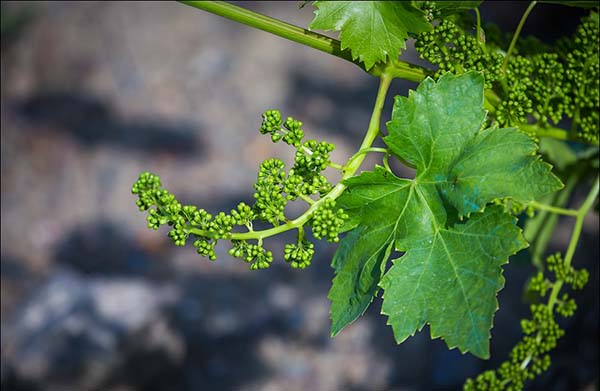
Diseases:
- From mildew, anthracnose and black spot (fomopsis) - Ridomil Gold, Quadris, Strobi (complex remedy for mildew and oidium), Acrobat (MC and Top), Pergado M, Ditan M-45, Delan.
- From oidium - Tiovit Jet (and ticks), Quadris (complex remedy for mildew and oidium), Strobi, Skor, Topaz, Collis, Vivando.
- From gray rot - Horus.
- From white rot - Horus.
- From black rot - Skor and Dinali.
From a complex of rot (gray, white and black), treatments begin to be carried out at the beginning of flowering (at the beginning of budding it is still early).
Pests:
- Processing continues from ticks (felt and web) - Caesar, Fufanon-Nova, Karate Zeon, Vertimek, BI-58, Tiovit Jet (and from oidium).
- Processing begins with a nail roll - Caesar, Insegar, Voliam Flaxi, Proclame, Lufox, BI-58.
Bloom
This treatment is carried out, as a rule, only if the weather is unfavorable (it rains and very high humidity - a favorable environment for development gray rot, anthracnose and mildew).
If the weather is dry and clear, then you don't need to spray.
By the way! Low humidity and high temperature (dry and hot) are favorable conditions for development oidium, but during the flowering period it is not processed from it.
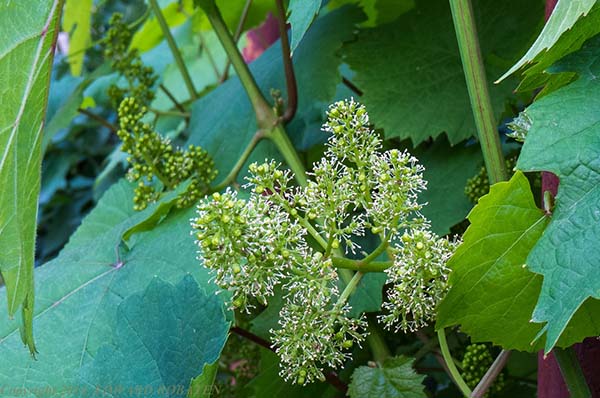
As for suitable preparations, systemic agents are also used, but if possible without copper (some varieties do not react well to such spraying).
Diseases:
- From mildew, anthracnose and black spot (fomopsis) - Ridomil Gold, Quadris (complex remedy for mildew and oidium), Strobi, Acrobat (MC and Top), Pergado M, Ditan M-45, Delan.
- From oidium - Tiovit Jet (and ticks), Strobi (complex remedy for mildew and oidium), Quadris, Skor, Topaz, Collis, Vivando, Dinali (and black rot).
- From gray rot - Horus, Teldor, Switch.
- From white rot - Horus, Teldor and Switch.
- From black rot - Skor and Dinali (and from oidium.
Pests:
- From felt mites - Caesar, Vertimec.
- Processing from the nail roll continues - Caesar, Insegar, and processing begins with an ordinary leaf roll - Karate Zeon (universal remedy for ticks and ordinary leaf rollers).
- Spraying begins from leafhoppers and thrips - Voliam Flexi, Aktara.
However! You need to be more careful with treatments for pests during the flowering period, it is better not to use insecticides at all, otherwise you can kill the bees ...
Formation of berries with "peas"
If you notice the first signs of illness and pest attacks, then continue using systemic drugs, or again switch to using contact means, and even better - biological products (if the vine is clean).
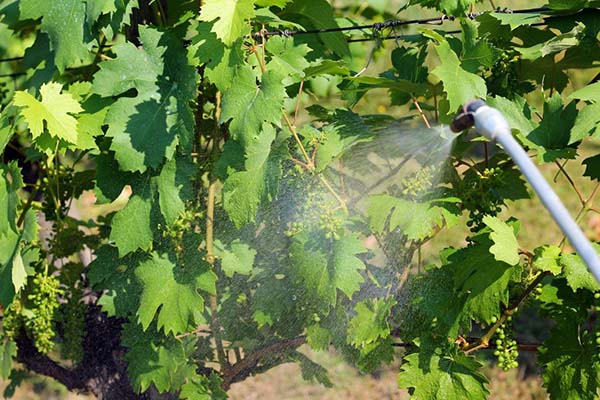
Diseases:
- From mildew, anthracnose and black spot (fomopsis) - Ridomil Gold, Quadris and Strobi (complex remedies for mildew and oidium), Acrobat (MC and Top), Pergado M, Ditan M-45, Delan (both contacts).
- From oidium — Tiovit Jet (contact facility, also from ticks), Strobi and Quadris (complex remedies for mildew and oidium), Skor, Topaz, Collis, Vivando (waiting time only 10 days), Dinali (and from black rot).
- From gray rot - Horus, Teldor, Switch.
- From white rot - Horus, Teldor and Switch.
- From black rot - Skor, Dinali (and from oidium).
Pests:
- From ticks (felt and web) - Caesar, Fufanon-Nova, Karate Zeon, Vertimek, BI-58, Tiovit Jet (contact facility, also from oidium).
- From a nail roll - Caesar, Insegar, Proclame, Lufoks, BI-58, Voliam Flexy, from an ordinary leaf roll - Karate Zeon.
- From leafhoppers and thrips - Voliam Flexy.
Ripening (closing of bunches and beginning of coloring of berries)
If the first 4-5 treatments did not help (and usually they are enough), then now it is advisable to use only contact fungicides and biologicals or those systemic drugs that have a short waiting time (10-15 days, preferably no more).
In this case, treatments are carried out every 10-14 days or after each rain (relevant for contact agents that are washed off).
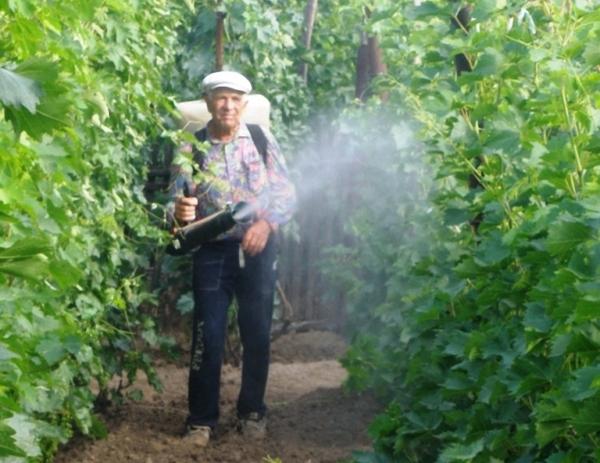
Diseases:
- From mildew, anthracnose and black spot (phomopsis) - Strobe (complex remedy for mildew and oidium, waiting period - 10 days), Pergado M, Ditan M-45, Delan (both contacts).
- From oidium — Tiovit Jet (contact facility, also from ticks), Strobe, Speed and Vivando (all have a waiting period of only 10 days), Dinali (and from black rot).
- From gray rot — Horus (waiting time - only 7 days), Teldor, Switch.
- From white rot - Horus, Teldor and Switch.
- From black rot - Skor, Dinali (and from oidium).
Last two treatments from a complex of rot (gray, white and black), you must definitely before the berries close in the bunch and at the beginning of the coloring of the berries.
Pests:
- From the nail roll - Caesar, Proclame, Voliam Flexy, from the usual roll - Karate Zeon.
- From leafhoppers and thrips - Voliam Flexy.
How to properly spray grapes in spring
Basic rules and recommendations for effective spring spraying of grapes against diseases and pests:
- During the preparation of solutions and spraying of the vineobserve safety precautions... If the packaging of the drug says that you need to wear special clothes (gown, overalls, raincoat), goggles and a respirator, rubber gloves, then you need to wear it.
- Spraying grapes is best in dry, cloudy and calm weather.
Carry out processing in sunny weather it is highly undesirable, since, quickly drying, the drugs become ineffective or do not work at all.
Spraying is best done in cloudy, calm weather, but not in the rain: after the rain, the branches are damp, like a thin "film" of water on them. And spraying is droplets of solution, which cover the plant with a thin "film" of drops in the same way. If processing is carried out, then the concentration of the solution will decrease, and the processing efficiency will decrease.
- Spraying is desirable in the morning (after dew has dried) or late at night (after sunset).
Too early treatment will be ineffective due to the dew that has not evaporated and the high humidity of the air.
- Processing must be carried out after removing the winter shelter, spring pruning andgarters of bushes to trellises.
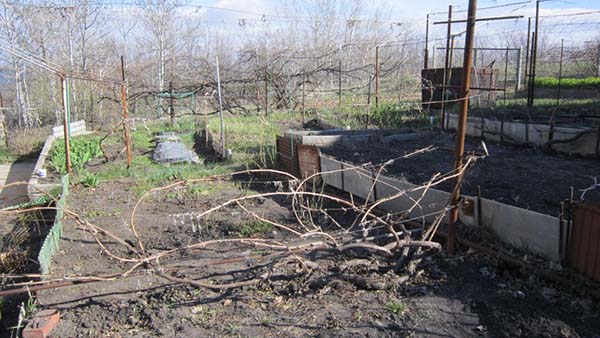
By the way! To further protect the cut sites, it is ideal to spray the bushes with copper sulfate or Bordeaux liquid, in other words, copper should be included in the fungicide.
Copper preparations are excellent at fighting mildew.
- Not very desirable spray against pests (insecticides) during flowering, can harm bees. But against diseases it is quite acceptable (especially against gray rot)
- Carefully read the instructions for use of each drugespecially regarding processing frequency (after how long it is necessary to repeat the spraying, what is the period of action of the drug) and waiting period (after what time can you eat berries after processing).
By the way! At each stage, you can use both the same drugs (in order to save money), and new ones (in this case, you need to change the active substance so that there is no addiction, resistance - this will be more effective), or alternate (use alternately).
- All prepared solutions should be pass through a filter meshso as not to clog the sprayer.
- Suitable for dissolving almost all drugs room temperature water (for vitriol, it is advisable to use hot water around + 40-50 degrees).
What if you are using a biological productthen water better to take settled or filtered, i.e. chlorine free.
How to treat grapes in the spring from diseases and pests:best drugs
Before proceeding with the procedure, it is natural that you need to decide (and first find out) how you can process grapes in spring.
By the way! In the previous paragraph "When to spray the grapes" in what period and from what it is necessary to process grapeswere and remedies are given against specific diseases and pests. But you can use any other drugs of similar action.
Now for spring spraying the garden, there are many different tools that will help you effectively cope with any pests and diseases. But in order to know exactly when and how to use them best, you need to figure out what their features and differences are.
Note! At each stage, you can use both the same drugs (in order to save money), and new ones (and it is better to change the active ingredient so that there is no addiction, resistance - this will be more effective), or alternate (use alternately).
Important! The instructions for each drug always indicate when (in what time frame) they need to be processed.
So, for effective spring processing of grapes, you will need:
- fungicides (drugs to fight diseases);
- insecticides (insect pest control agents);
There is also acaricides - means for fighting ticks. But, as a rule, insectoacaricides (against ticks and other pests) can be found more often.
- insectofungicides (complex preparations acting simultaneously against pests and diseases).
Moreover, these funds (fungicides and insecticides) can be:
- chemical origin (chemicals);
- biological (biological products).
Of course, there are also folk remediesfor example various herbal solutions and infusions... But their efficiency is very, very limited.
Chemicals and biologicals
Unlike biological products, chemicals are much faster and more reliable. In addition, the use of "chemistry" is often vital, the only way to cure (more precisely, save) a culture from fungal diseases and / or get rid of annoying pests.
The treatment of grapes with chemical agents in spring does not have any negative consequences for the future harvest and human health, since after the waiting period all pesticides (including chemical ones) are completely removed.
TOof course, and it should be mandatory follow the recommendations for dosage and timing of spraying (pay attention to drug waiting time = after how long the field of processing berries can be eaten).
It should be understood that biological drugs and folk remedies are more gentle, which is permissible in the following cases:
- with a small number of pests;
- at the initial stage of development of a fungal disease or with a mild infection, as well as as a prophylaxis.
How to determine the type of fungicide to use
Naturally, it is fundamentally important to be able to determine, by the state of your grapes, which drug should be used.
Note! Fungicides are divided into systemic and contact, as well as therapeutic and prophylactic (protective).
- If you have recently sprayed grapes, leaves are clean, no signs of disease, it is best to use preventive (protective) drugs.
- If you noticed signs of illness, even if only on some leaves, then you already need to apply medicinal drugs.
By the way! As a rule, many drugs are protective and therapeutic action.
- Systemic drugs They are "absorbed" by the plant and act from the inside, so that by and large it is not very important to process the entire leaf surface. Also, some systemic drugs transfer their active substance to the tops of the vines, thus protecting the growing points from diseases.
Interesting! Moreover, most drugs are systemic contact action.
- Contact drugs work only where you put them. Therefore, where you do not apply them, the disease will remain, it will not go anywhere. That is why such processing must be done very carefully.
Important! But you should not overdo it either, since the preparations themselves often have an important recommendation "Do not let the liquid run off the sheet."
Chemical fungicides
Let's start with chemicals suitable for spring sprinkling of grapes against diseases. So, you can apply the following fungicides (means for combating fungal diseases):
Important! For one treatment, you need to choose only one drug (fungicide), and then use a new one (with another active substance) or alternate.
The active ingredients, the nature of the effect and the scope of application (against which diseases it works) are indicated in brackets.
Contact actions (washed away by rain):
- Bordeaux mixture (Copper sulphate and calcium hydroxide, 3% solution of Bordeaux liquid - before bud break, 1% solution - before flowering, from mildew, anthracnose, rubella);
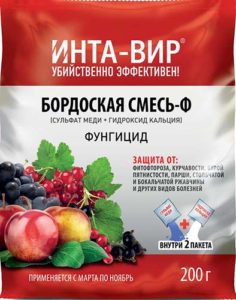
- Copper sulfate (Copper sulfate, from mildew, anthracnose);
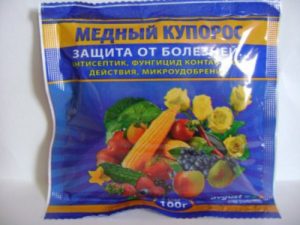
- Abiga peak (Copper oxychloride, contact fungicide of protective action, against mildew and oidium, anthracnose and phomopsis);
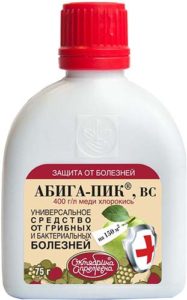
- Hom (Copper oxychloride, contact fungicide of protective action);
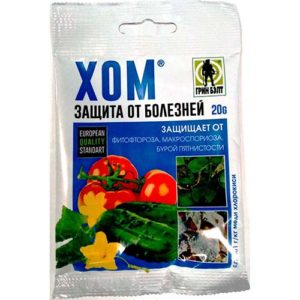
Abiga-peak (400 g / l) and Hom (861 g / kg) are almost analogues.
- Tiovit Jet (Colloidal sulfur, contact fungicide of protective action, against powdery mildew and mites);
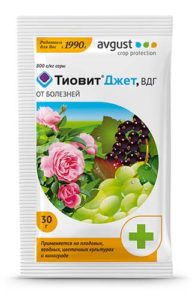
Sometimes on sale you can find simply colloidal sulfur.
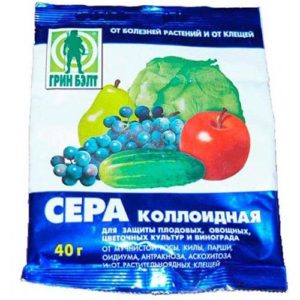
Note! It is useless to work with colloidal sulfur (Tiovit Jet) in cool weather (below +20): the optimum temperature is +25 degrees, then the sulfur will evaporate and have a detrimental effect on ticks.
However! At temperatures above +30 degrees, sulfur cannot be used, because the treatment may cause burns on the leaves.
- Ditan M-45 (Mancozeb, contact fungicide of protective action against mildew and phomopsis);
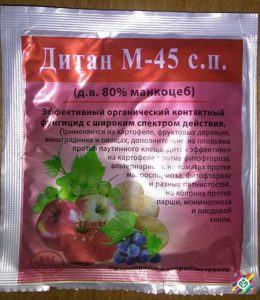
- Delan (Dithionon, contact fungicide of protective and treating actions against mildew, phomopsis);
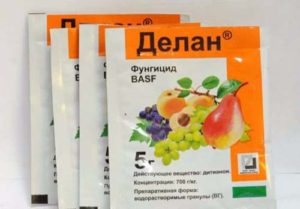
- Cabrio Top (Metiram (Polycarbocin) + Pyraclostrobin, contact fungicide of protective action, against mildew and oidium, anthracnose and phomopsis);
System contact facilities:
- Cuprolux (Copper oxychloride and Cymoxanil, systemic contact fungicide, protectivecurative actions, from mildew, anthracnose and phomopsis).
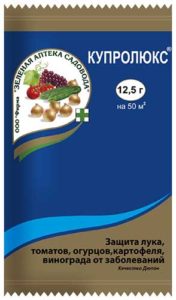
Analogs - Kurzat R, Ordan, Broneks.
- Oxyhom (Copper oxychloride + Oxadixil, systemic contact fungicide of protective action, against mildew);
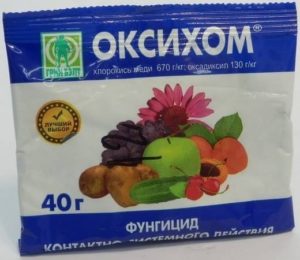
Analogs - Homoxil, Proton Extra.
- Tsikhom (Copper oxychloride + Tsineb, systemic contact fungicide of protective action, against mildew, anthracnose and phomopsis);
Analog - Kuprozan.
- Pergado M (Copper oxychloride and Mandipropamide, systemic contact fungicide of protective and healing action, against mildew and anthracnose);
- Switch (Fludioxonil and Cyprodinil, contact-systemic fungicide of protective and curative action, against gray rot, white rot and a complex of berry rot (moldy penicillous, aspergillus, rhizopus);
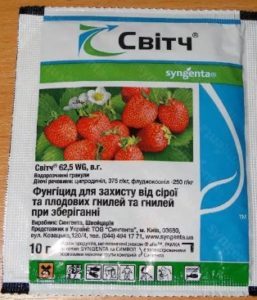
- Topsin-M (Thiophanate methyl, a systemic contact fungicide of a protective action against powdery mildew, gray mold, phomopsis and anthracnose);
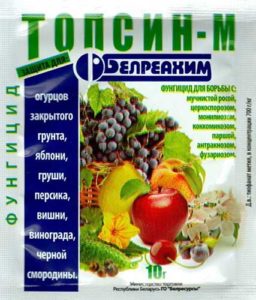
Analogs - Thiophene, Thioma.
- Quadris (Azoxystrobin, systemic contact protective fungicide, against mildew and oidium, phomopsis, anthracnose);
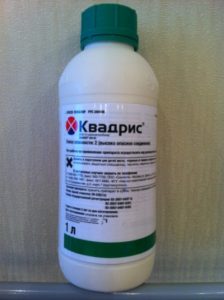
- Quadris Top (Azoxystrobin + Difenoconazole, systemic contact protective fungicide, against mildew and oidium, phomopsis, anthracnose);
- Medea (Difenoconazole and Flutriafol, a systemic contact fungicide of protective and healing action, from oidium, phomopsis, gray rot and black rot);
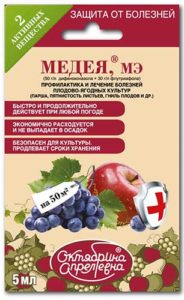
- Revus Top (Difenoconazole + Mandipropamide, a systemic contact fungicide of protective and healing action, from mildew and oidium);
- Revus (Mandipropamide, a systemic fungicide of protective and healing action, against mildew).
- Profit Gold (Famoxadone + Cymoxanil, systemic contact fungicide of protective and healing action, from mildew, phomopsis);
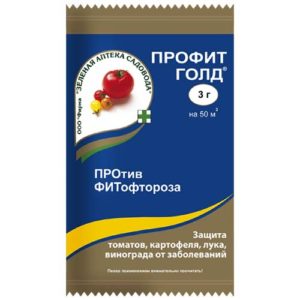
Analogs - Thanos, Ulysses.
- Acrobat Top (Dimethomorph + Dithianon, a systemic contact fungicide of protective and curative action, against mildew, fopomsis);
- Acrobat MC (Mancozeb + Dimethomorph, a systemic contact fungicide of protective and curative action, against mildew, fopomsis);
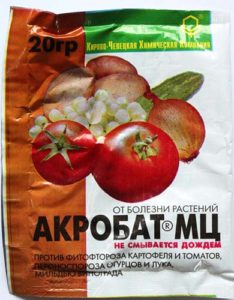
- Ridomil Gold MC (Mancozeb + Mefenoxam, a systemic contact fungicide of protective and therapeutic action, against mildew, phomopsis and anthracnose);
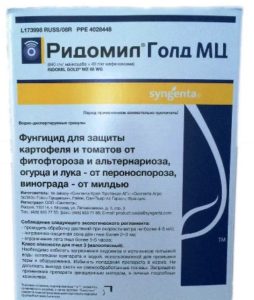
- Ridomil MC (Mancozeb + Metalaxil, systemic contact fungicide of protective and therapeutic action, against mildew, phomopsis and anthracnose);
Analogs - Acidan, Metaxil, Metamil MC.
- Ordan MC (Mancozeb + Cymoxanil, a systemic contact fungicide of protective and therapeutic action, against mildew, phomopsis, anthracnose);
Analog - Rapid Gold.
- Bellis (Boscalid and Pyraclostrobin, systemic contact fungicide of protective action, against mildew and mildew, gray rot and other rot);
- Signum (Boscalid and Pyraclostrobin, systemic contact fungicide of protective action, against mildew and mildew, gray rot and other rot);
- Speed (Difenoconazole, a systemic contact fungicide of a protective and curative action, against powdery mildew, phomopsis, rubella and a complex of rot (especially black);
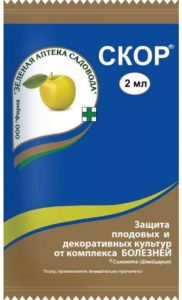
Analogs preparations - Raek, Keeper, Pure color.
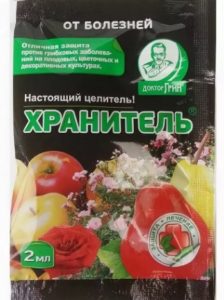
- Fundazol (Benomil (Fundazol), systemic contact protective fungicide and insecticide, against powdery mildew, gray rot and other rot).
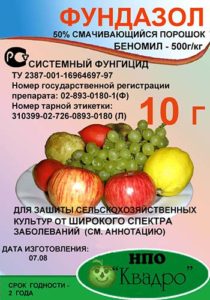
Systemic drugs:
- Tilt (Propiconazole, systemic fungicide of protective and curative action, against powdery mildew, gray mold);
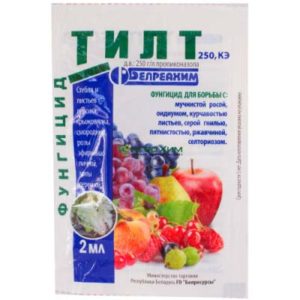
Analogs - Agrolekar, Forecast, Chistoflor.
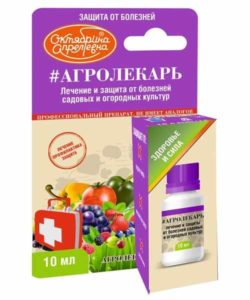
- Bayleton (Triadimefon (Bayleton), systemic fungicide of protective and healing action, against powdery mildew and gray mold);
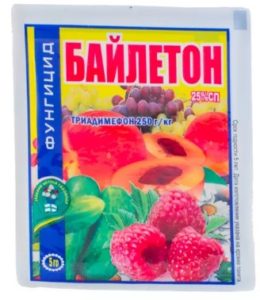
Analogs - Bizafon, Privent.
- Horus (Cyprodinil, a systemic fungicide of protective and curative action, against gray rot, white rot and a complex of berry rot: olive, moldy, black aspergillus, watery rhizopus);
Note! Chorus shows the highest efficiency at low temperatures (from +5 to +15 degrees), it is not recommended to carry out processing at an air temperature of more than +25 degrees.
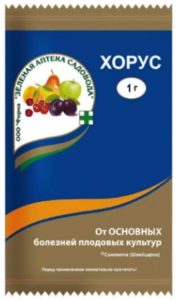
- Topaz (Penconazole (Topaz), a systemic fungicide of a protective effect, from powdery mildew);
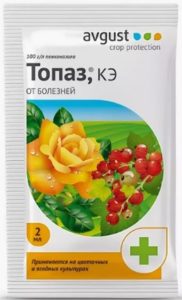
- Strobe (Kresoxim-methyl, a systemic fungicide of protective and curative action, against mildew and oidium, black rot);
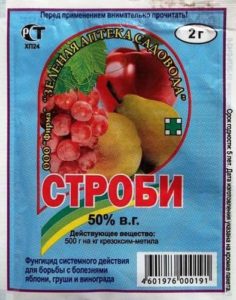
- Teldor (Fenhexamide, a local systemic fungicide of protective action, against gray mold);
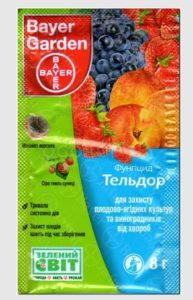
- Cantus (Boscalid, systemic fungicide of protective action, against gray rot);
- Collis (Boscalid and Kresoxim-methyl, a systemic fungicide of protective-curative action, from oidium);
- Vivando (Metrafenone, a systemic fungicide of a protective action, from oidium);
- Moon Experience (Pyrimethanil and Fluopyram, a systemic fungicide of a curative action, against powdery mildew, gray rot and black rot);
- Moon Tranquility (Pyrimethanil and Fluopyram,systemic fungicide of the curative action, from oidium, gray rot and black rot);
- Consento (Propamocarb hydrochloride and Fenamidone, systemic fungicide of protective action, against mildew);
- And other contact and systemic fungicides of a wide spectrum of action.
Advice! Carefully study the instructions: the scope of application of the drug (against what diseases), terms of application and waiting time, frequency of use and dosage (in what proportion to mix with water)!
Chemical insecticides
As for the preparations suitable for spraying the vines in the spring against pests, the following can be used insecticidal and acaricidal agents:
Important!For one treatment, you need to choose only one drug (insecticide or acaricide), and then use a new one (with another active substance) or alternate.
The active ingredients, the nature of the effect and the scope of application (against which pests it works) are indicated in brackets.
- Aktara (Thiamethoxam (Aktara), systemic insecticide of intestinal action, from leafhoppers and thrips);
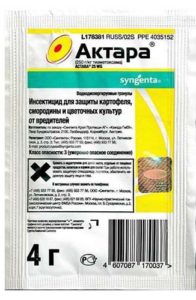
- Inta-vir (Cypermethrin,enteric insecticide, from leaf rollers);
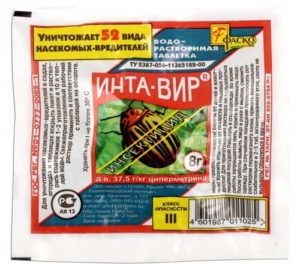
Shar Pei and Inta-vir are analogues!
- Fufanon-Nova (Malathion (Karbofos), enteric insectoacaricide fromgrape roll and mites);
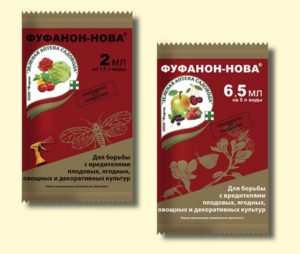
- Karate Zeon (Lambda Cyhalothrin,enteric insecticide from ticks and leaf rollers);
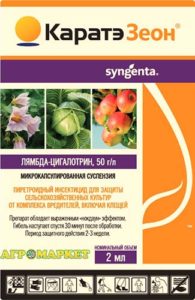
- Masai (Tebufenpirad, acaricide of intestinal action, against ticks);
Has a strong ovicidal action against oviposition.
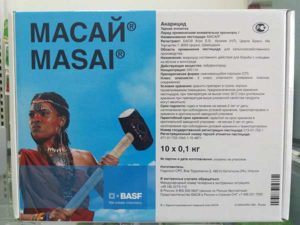
- Apollo (Clofentesin, contact acaricide ovicidal (against oviposition), against ticks);
- BI-58 (Dimethoate, systemic insectoacaricide of intestinal action, from ticks and bunchworm).
- Vertimek (Abamectin, an enteric insecticide from spider mites);
- Insegar (Fenoxycarb, insecticide of intestinal action from grape roll);
- Voliam Flexy (Thiamethoxam (Aktara) and chlorantraniliprol, a systemic insecticide of intestinal action against bunchy leafworm, thrips and leafhoppers);
- Lufox (Lufenuron and Fenoxycarb, an insecticide of intestinal action from grape roll);
- Brand (Emamectin benzoate,insecticide of intestinal action fromgrape roll);
- Caesar (Alpha cypermethrin, enteric insecticide, from ticks and bunchworm);
- And other broad-spectrum insecticides;
Advice! Carefully study the instructions: the scope of the drug (against which pests), timing, dosage.
Biologicals: fungicides and insecticides
Among biological agents for protecting grapes from diseases and pests, fungicides, insectoacaricides, and one insectofungicide can also be distinguished.
Note! As a rule, almost all biological products begin their work only under the condition of a sufficiently high air temperature (+15 degrees), therefore they begin to be used only before flowering and after flowering, while the first and second treatments must be carried out using chemicals.
Biologicals fungicidal action (against diseases):
- Alirin-B (Bacillus subtilis, strain B-10 VIZR, systemic contact fungicide of protective and therapeutic action, against mildew and oidium, gray rot);
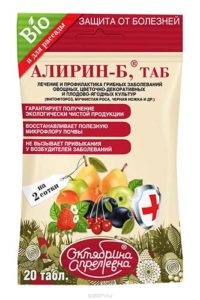
- Gamair (Bacillus subtilis strain M-22 VIZR, a systemic contact fungicide of protective and curative action, against gray mold).
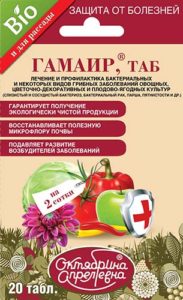
- Baktofit (Bacillus subtilis strain IPM 215, contact fungicide of protective and therapeutic action, from oidium);
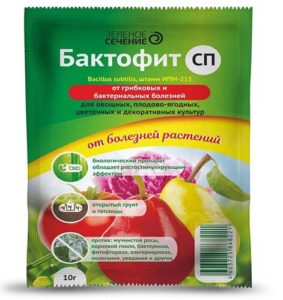
- Baxis (Bacillus subtilis strain 63-Z, protective and curing fungicide against mildew and oidium, gray mold);
- Vitaplan (Bacillus subtilis strain VKM-B-2604D and VKM-V-2605D, a protective fungicide against mildew and oidium);
- Pentaphagus (virions of five strains of bacterial viruses, fungicide of protective and therapeutic action, against mildew and oidium);
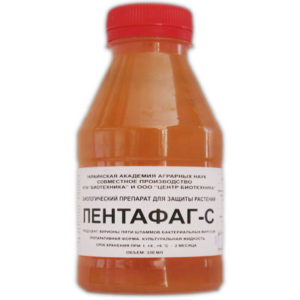
- Planriz (Pseudomonas fluorescens strain AP-33, contact fungicide, against mildew and oidium, gray rot);
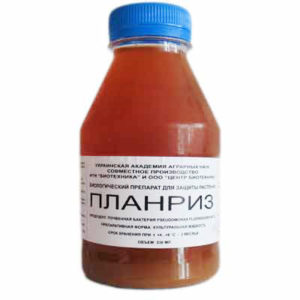
- Rizoplan (Pseudomonas fluorescens strain AP-33, contact fungicide, against mildew and oidium, gray rot);
Planriz and Rizoplan are complete analogues.
- Sporobacterin (Bacillus subtilis and Trichoderma viride, strain 4097, systemic contact fungicide of protective and therapeutic action, against mildew and oidium, gray rot);
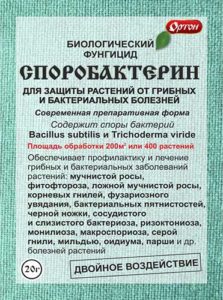
- Fitosporin (Bacillus subtilis strain 26 D, a systemic fungicide of protective and curative action, against mildew and powdery mildew, gray mold).
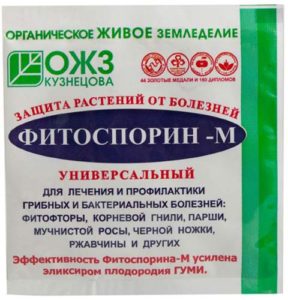
- Trichoderma Veride (Trichoderma veride, strain 471, protective fungicide, against gray mold);
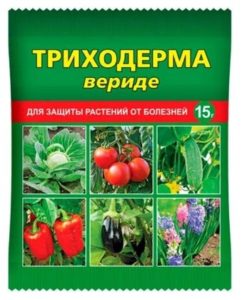
- Trichoplant (Trichoderma lignorum, protective fungicide, against gray mold);
- Trichocin (Trichoderma harzianum, protective fungicide, against gray mold);
Trichodermin, Trichoplant, Trichocin and Trichoderma Veride are all based on Trichoderma mushrooms.
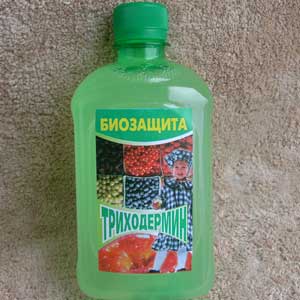
- Glyocladin (Trichoderma harzianum strain 18 VIZR, a systemic contact fungicide of protective and curative action, against gray mold).
Biologicals insecticidal and acaricidal action (against pests, including ticks):
- Fitoverm (Aversectin C, enteric insectoacaricide, from ticks);
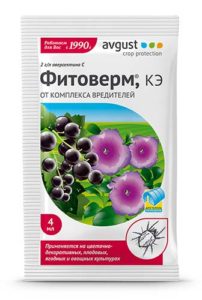
Fitoverm, Aktofit and Kleschevit Are full analogs.
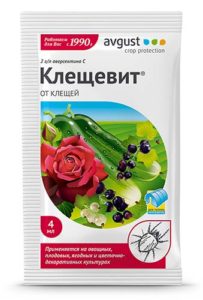
- Bitoxibacillin (Bacillus thuringiensis var. thuringiensis, intestinal insecticide, from the bunch of leaf rollers, spray in the phase of loosening the inflorescences and setting the berries);
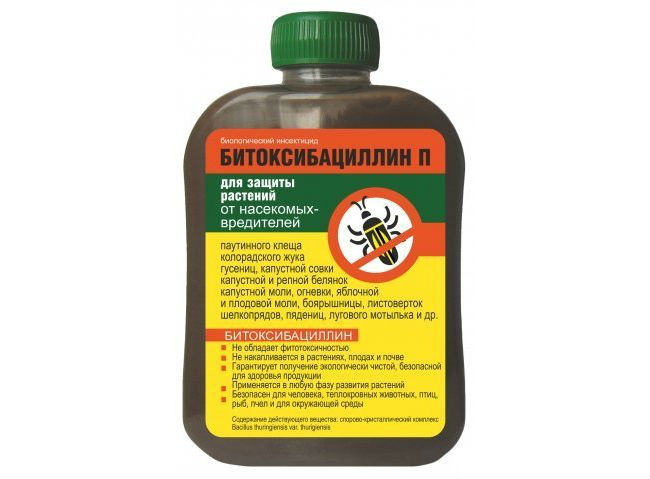
- Lepidocide (Bacillus thuringiensis var. kurstaki, intestinal insecticide, from grape leafworm, spray in the phase of loosening inflorescences and setting berries);
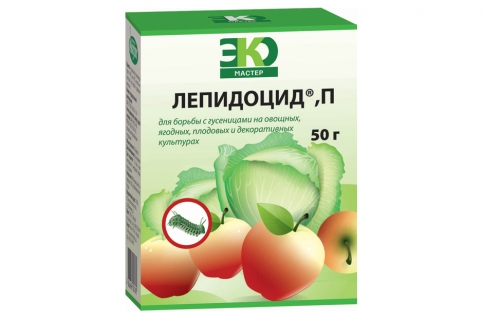
- Gaupsin (two strains of soil bacteria Pseudomonas aureofaciens, complex action insectofungicide, from mildew and oidium, gray rot, from ticks and leaf rollers).
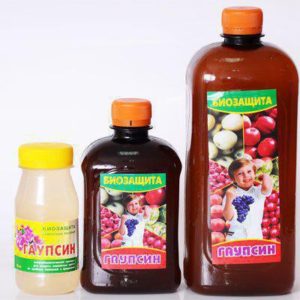
Note! Yes, biologics have their advantages (they are environmentally friendly), but we have to admit that they are not as effective as chemical ones.
Tank mixtures (fungicides + insecticides)
Note! Not all drugs can be mixed. For example, practically nothing can be mixed with Bordeaux liquid and copper oxychloride (due to the alkaline reaction).
Therefore, before preparing the mixture, you need to find out if the drugs are compatible with each other. To do this, you should carefully read the manufacturer's recommendations indicated on the back of the package.
For spring spraying of grapes (except for the first one, when the buds are still sleeping), you can prepare the following tank mixtures (fungicide + insecticide):
Advice! Avoid mixing more than two components (maximum 3). First, there may be undesirable reactions between the components, and secondly, too much pesticide load, which is especially difficult for young plants.
Chemical fungicides and insecticides:
- Strobi (from mildew and oidium) + BI-58 (from a pest complex);
- Quadris (from mildew and oidium) + BI-85 (from a pest complex).
- Ridomil Gold MC (from mildew) + Topaz (from oidium);
- Ridomil Gold MC (mildew) + Topaz (from oidium) + Aktara (leafhoppers, thrips);
- Ridomil Gold MC (mildew) + Tiovit Jet (against oidium and ticks);
- Cabrio Top (mildew and oidium) + Caesar (from ticks and grape leafworm);
- Cabrio Top (mildew and oidium) + Bi-85 (from the pest complex);
- Other.
Advice! When preparing the tank mix, follow the order of adding pesticides:
- water-soluble granules - VG,
- wettable powders - SP,
- water-dispersible granules - VDG,
- suspension concentrates - KS,
- emulsion concentrates - EC,
- water-soluble concentrates - VK,
- aqueous solutions,
- alcohol solutions.
Biological fungicides and insecticides:
- Fitoverm (insecticide against ticks) + Bitoxibacillin (against other insect pests) + Guapsin (complex action insectofungicide);
- Fitosporin (fungicide) + Bitoxibacillin (insecticide);
- Fitoverm (insecticide) + Bitoxibacillin (insecticide) + Guapsin (insectofungicide);
- Bitoxibacillin (insecticide) + Guapsin (insectofungicide);
- Lepidocide (insecticide) + Guapsin (insectofungicide).
- And many others. dr.
Folk remedies
Folk remedies have long been used to treat not only grapes, but the entire garden against diseases and pests.
Important! It should be understood that spraying with such "folk remedies" has very limited effectiveness.
Soda
A truly folk remedy in the fight against real (oidium) and false (mildew) powdery mildew, as well as anthracnose on grapes, is the preparation of a soda solution.
Recipe: 40-50 grams soda ash for 10 liters of water + you can add 40-50 grams of grated laundry or green soap.
Wood ash
Another natural folk remedy for the treatment of grapes from powdery mildew (real and false), as well as anthracnose, is wood ash.
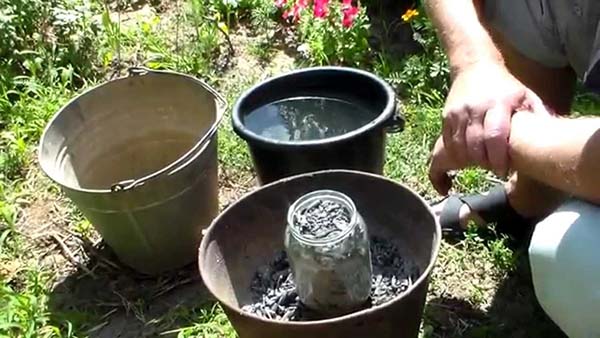
To prepare an ash solution for processing grape bushes, you will need:
- Pour 400 grams of ash into a bucket of water and stir well.
- Let it brew for 1-2 days so that the ash extract is the most effective.
- Add 3 tbsp. spoons (40-50 grams) of laundry soap or green soap (for better adhesion).
- Strain, pour into a sprayer and process.
By the way!Wood ash - it is also an excellent potash fertilizer, that is, it is an excellent foliar feeding.
Video: processing grapes with an extract of ash from oidium, mildew and anthracnose
Whey, sour milk and other acidic products
Another safe way to control powdery mildew on grapes is to spray it with whey or sour milk.
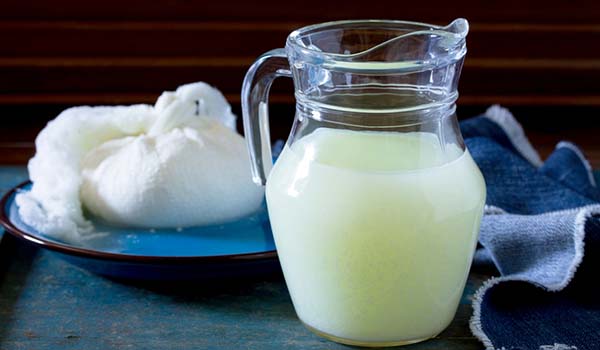
Infusion horsetail... Recipe: Boil 100 grams of dry horsetail per 5 liters of water, let it brew for 12 hours, add 40-50 grams of laundry or green soap.
Infusion fermented sour bread... Recipe: 1 kg of dry crusts per 10 liters of water, 1-2 tbsp. tablespoons of sugar for better fermentation, let it brew for 3-5 days.
Interesting! The essence of the application acidic (horsetail, whey) and alkaline (soda, wood ash) solutions in the fact that neutral acidity is most favorable for the fungus, while an increase or decrease in acidity should cause its death.
Mature hay
A full bucket of rotten hay is filled, filled with water and infused for about 4-6 days in a warm place. During this time, a hay stick appears in the mixture (you get an analogue of "Fitosporin"), which, when sprayed, should "gobble up" the powdery mildew fungus. However, first the infusion must be diluted with water in a ratio of 1 to 3.
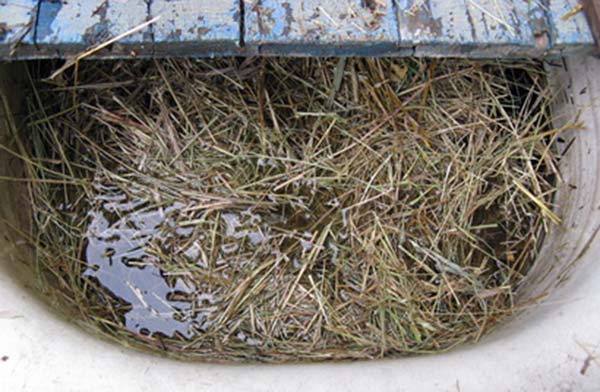
Garlic infusion
Also, in the fight against powdery mildew and some pests of grapes, many advise using garlic infusion (250 grams of chopped cloves per 10 liters of water, let it brew for 24 hours).
Infusion of onion peel
As a prophylaxis against fungal diseases and pests (mites), before and after flowering in spring, you can try to process the vine with infusion onion peel... The pot is filled with husks (150-200 grams per 10 liters), filled with water and put on fire. After the mixture has boiled for 20-30 minutes, it is removed and left for 12-24 hours. At the end of the time, bring the volume of water to 10 liters, filter and spray the vines.
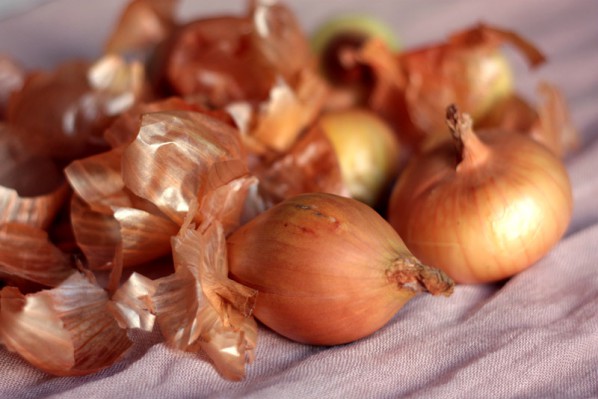
Dill
According to some reports, if planted next to grapesdill (around the perimeter), then this will partially help protect the bushes from mildew (downy mildew). But again, one should not rely heavily on such folk trick.
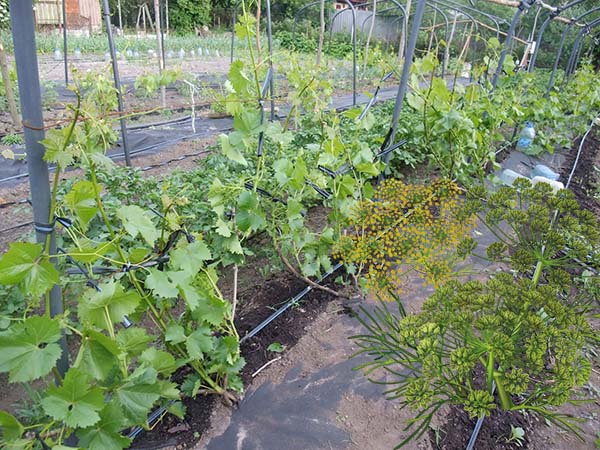
Important! It should be understood that folk remedies are relatively weak remedies for the treatment of grape diseases, which are not suitable for the fight, if the disease is raging in full force in the vineyard, as a maximum - for prevention (protection).
Thus, processing grapes in spring is the most important component of spring maintenance of your vineyards. Timely spraying will protect the grape bush from diseases and pests, which will have a positive effect on the quality and quantity of the future harvest.
Video: a comprehensive plan for protecting grapes from diseases and pests, or when and how to process the vine from spring to autumn


INFORMATION SUPER
interestingly someone read to the end?
I understand that it turned out very "long", I just tried to present as much useful information as possible so that there were no questions left (((